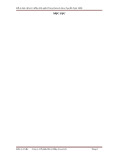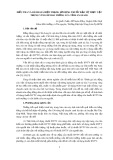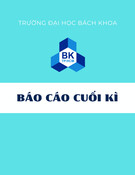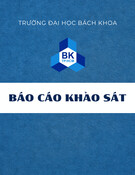
BioMed Central
Page 1 of 15
(page number not for citation purposes)
Journal of Immune Based Therapies
and Vaccines
Open Access
Original research
IMP321 (sLAG-3), an immunopotentiator for T cell responses
against a HBsAg antigen in healthy adults: a single blind randomised
controlled phase I study
Chrystelle Brignone, Caroline Grygar, Manon Marcu, Gaëlle Perrin and
Frédéric Triebel*
Address: Immutep S.A., Parc Club Orsay, 2 rue Jean Rostand 91893, Orsay, France
Email: Chrystelle Brignone - cbrignone@immutep.com; Caroline Grygar - clallouet@immutep.com; Manon Marcu - mmarcu@immutep.com;
Gaëlle Perrin - gperrin@immutep.com; Frédéric Triebel* - ftriebel@immutep.com
* Corresponding author
Abstract
Background: LAG-3 (CD223) is a natural high affinity ligand for MHC class II. The soluble form
(sLAG-3) induces maturation of monocyte-derived dendritic cells in vitro and is used as a potent
Th1-like immune enhancer with many antigens in animal models. To extend this observation to
human, a proof of concept study was conducted with a clinical-grade sLAG-3, termed IMP321,
coinjected with alum-non-absorbed recombinant hepatitis B surface antigen.
Methods: In a randomised, single blind controlled phase I dose escalation study, 48 seronegative
healthy volunteers aged 18–55 years were vaccinated at 0, 4 and 8 weeks by subcutaneous injection
with 10
μ
g HBsAg mixed with saline (control) or with IMP321 at one of four doses (3, 10, 30 and
100 μg). To evaluate the efficacy of this three injections over 2 months immunization protocol, an
additional control group was injected with the commercial vaccine Engerix-B®.
Results: IMP321 was very well tolerated. Indeed, a lower incidence of adverse events was
reported from the HBsAg plus IMP321 groups than from the Engerix-B® group. HBsAg-specific
antibody responses (anti-HBs) appeared sooner and were higher at 8 and 12 weeks in IMP321
recipients compared to HBsAg control subjects. More importantly, increased numbers of
responders to HBsAg were found in IMP321 recipients compared HBsAg group, as revealed by
higher post-vaccination frequencies of CD4 Th1 or CD8 Tc1 antigen specific T cells. IMP321
induced CD4 Th1 antigen-specific T cells in some of these naïve individuals after only one injection,
especially in the 10 and 30 μg dose groups.
Conclusion: IMP321 as an adjuvant to HBsAg was well-tolerated and enhanced T cell response
vaccine immunogenicity (i.e. induced both CD4 Th1 and CD8 Tc1 antigen-specific T cells). This
latter property has allowed the development of IMP321 as an immunopotentiator for therapeutic
vaccines.
Published: 29 March 2007
Journal of Immune Based Therapies and Vaccines 2007, 5:5 doi:10.1186/1476-8518-5-5
Received: 15 December 2006
Accepted: 29 March 2007
This article is available from: http://www.jibtherapies.com/content/5/1/5
© 2007 Brignone et al; licensee BioMed Central Ltd.
This is an Open Access article distributed under the terms of the Creative Commons Attribution License (http://creativecommons.org/licenses/by/2.0),
which permits unrestricted use, distribution, and reproduction in any medium, provided the original work is properly cited.

Journal of Immune Based Therapies and Vaccines 2007, 5:5 http://www.jibtherapies.com/content/5/1/5
Page 2 of 15
(page number not for citation purposes)
Background
A clinically effective therapeutic vaccine to fight viruses or
tumour requires the generation and expansion of specific
cytotoxic T lymphocytes (CTL) able to proliferate and/or
secrete Th1-type cytokines such as IL-2, IFNγ or TNF-α
after antigen-specific stimulation. Since few years, many
efforts have been done to attempt to amplify the immune
response and to shift it towards an adequate response
using adjuvants. Almost all therapeutic vaccine adjuvant
approaches use ligands for one of the Toll-like receptors
(TLR) expressed on DC. The most studied of the TLR lig-
ands are the TLR9 ligands deoxycytidyl-deoxyguanosin
oligodeoxynucleotides (CpG ODNs) or immunostimula-
tory DNA sequences (ISS) that are potent inducers of
inflammation ("danger signals").
In addition to the TLR agonists that are innate immunity
ligands, the immune response involves two adaptive
immunity ligands that are expressed on activated T cells
and bind to non-TLR receptors expressed on DC. These are
the CD40L and lymphocyte activation gene-3 (LAG-3 or
CD223) human proteins. Soluble forms have been tested
at the preclinical and/or clinical stage as vaccine immuno-
logical adjuvants. Clinical development of soluble CD40L
(sCD40L) has been hampered by an increased risk of
thrombosis due to direct platelet activation by sCD40L
[1]. Soluble LAG-3 (sLAG-3) binds to MHC class II mole-
cules and induces dendritic cells (DC) to mature and
migrate to secondary lymphoid organs where they can
prime naïve CD4-helper and CD8-cytotoxic T cells [2-4],
leading to tumour rejection [5-7]. This maturation effect is
obtained specifically with sLAG-3 but not with any of the
tested MHC class II mAbs [3], and is dependent upon the
specific binding of sLAG-3 to MHC class II molecules
located in membrane lipid raft microdomains [8]. Finally,
the immunostimulatory activity of sLAG-3 in inducing
tumour-associated human antigen-specific CD8+ T cell
responses to a much greater extent than CpG ODN [9] has
been reported recently [10], further supporting the use of
this recombinant protein as a promising candidate adju-
vant for cancer vaccination.
In the present study, we report on the clinical and biolog-
ical effects, and safety evaluation of IMP321, a GMP-grade
sLAG-3 (hLAG-3Ig) protein, in a large randomised single
blind phase I clinical trial. The results of this proof-of-con-
cept clinical study in healthy volunteers using HBsAg as a
model antigen has paved the way for the development of
this human protein as an immunopotentiator for thera-
peutic vaccines.
Methods
Study design and subject selection
This single blind controlled phase I study was conducted
at the Aster-Cephac S.A. facility in Paris. Ethical Review
Board approval was obtained and each patient provided
voluntary informed consent. Eligible subjects were
healthy adult HBV vaccine naïve volunteers, aged 18–55,
with no serologic evidence of previously resolved or cur-
rent HBV infection. However, three of these were later
found to be seroconverted (but not seroprotected) at base-
line in the post study HBsAg antibodies determination
(subjects #019, 035 and 044). Other exclusion criteria
included liver enzyme levels outside the normal range,
chronic HIV or HCV infection, or evidence of any other
clinically significant acute or chronic disease. Subjects
receiving immune suppressive medication, and those
diagnosed with an immune or autoimmune dysfunction
were not considered for this study. Female subjects had to
have gone through the menopause for a least one year, as
evidenced by lack of menstruation for the last 12 months
and hormones (FSH, estradiol) blood level measurement
at screening confirming menopausal status.
Vaccines
For the production of a clinical batch of IMP321, CHO
DHFR- cells were transfected with a plasmid coding for the
D1-D4 extra-cellular domains of human LAG-3 fused to
the Fc tail of a human IgG1 [11]. A production clone was
selected after amplification in methothrexate. The final
container clinical batch used in the present study has a
concentration of 1.1 mg/ml IMP321 (a 200 kDa dimeric
protein) and 0.09 EU/mg endotoxin, 0.4 ng/ml DNA and
6 ng/ml host cell protein contents. Experimental vaccines
contained 10 μg yeast-derived recombinant HBsAg (pro-
vided by Rhein Biotech GmbH, Düsseldorf) alone or with
3, 10, 30, 100 μg IMP321 (hLAG-3Ig). All vaccines were
prepared by an unblinded pharmacist at the trial site and
were administered within 1 h of mixing using a 200 μl
injection volume. Each subject received three sub-cutane-
ous (s.c.) doses at 0, 4 and 8 weeks. The first and the third
injections were done in the deltoid area of the dominant
arm. The second injection was done in the deltoid area of
the non dominant arm. Subjects in another comparative
arm received an adult dose (1 mL) of Engerix-B® (Glaxo-
SmithKline, Rixensart, BE) that contains 20
μ
g of alum-
absorbed yeast-derived recombinant HBsAg, which was
administered intramuscularly.
Experimental groups
Subjects were enrolled sequentially into four cohorts
according to dose level of IMP321. Within cohorts, sub-
jects were randomised to receive an experimental vaccine
or control HBsAg alone in a 4:1 ratio. A total of 48 subjects
were immunized according to the planned three adminis-
tration schedules, 8 receiving control vaccines, 8 receiving
Engerix-B® and 32 receiving experimental vaccines with
IMP321 (n = 8 in each group). Two subjects were prema-
turely discontinued from the study after the first injection
and were replaced.

Journal of Immune Based Therapies and Vaccines 2007, 5:5 http://www.jibtherapies.com/content/5/1/5
Page 3 of 15
(page number not for citation purposes)
Safety evaluation
All subjects who received a dose of the study drug were
included in the safety evaluation (n = 50). Adverse effects
were identified by clinical examination at baseline and at
the following times post administration: first dose at 4 h,
48 h, one week, and 4 weeks (just prior to second dose);
second dose at 4h, 48 h, one week and 4 weeks (just prior
to third vaccine dose); third dose at 4 h, 48 h, one week
and 4 weeks. In addition, vital signs (blood pressure and
pulse rate) and oral body temperature were recorded at
pre-dose, 0.5 h, 1 h, 1.5 h, 2 h and 4 h post-dosing as well
as 48 h and 1 week after each injection. Laboratory tests
included a complete blood count, serum chemistry, liver
and renal function, and coagulation measures. Rheuma-
toid factors, anti-nuclear antibody titres (ANA) and anti-
IMP321 antibodies were measured at baseline and weeks
12.
Immunogenicity–humoral response
Immunogenicity results were analysed using the popula-
tion which completed the study (n = 48). To assess anti-
HBsAg responses, blood samples obtained at baseline and
8 and 12 weeks after the initial vaccine dosing, were
allowed to clot at room temperature for 15 minutes. Sam-
ples were centrifuged at 1,500 g at about 4°C for 10 min-
utes and the serum was aliquoted and stored in airtight
stoppered polypropylene tubes at -20°C. Sera were tested
by the Abbott AUSAB-MEIA (Abbott, Abbott Park, IL,
USA) and anti-HBs titres were expressed in mIU/mL based
on comparison with standards defined by the World
Health Organization (WHO). A protective titre was
defined as ≥ 10 mIU/mL. The commercially available hep-
atitis B vaccine Engerix®-B (20 μg HBsAg adsorbed on
alum) was used to ensure that our 3-months protocol
schedule was able to induce antibodies in most subjects.
Geometric mean of titres (GMT) was calculated using the
formula 10mean [log (Ab titers)] for each group at each time
point. Seronegative subjects have been given the arbitrary
value of 1 mIU/mL for GMT calculation.
Data analysis
The analyses for safety and tolerability parameters were
performed on all randomised subjects who received at
least one dose of study medication and who had post-
dose safety information (n = 50). Immunogenicity results
were analysed on the population which completed the
study (i.e. subjects who received 3 injections and had their
post-study visit) (n = 48). Anti-HBsAg titres measured in
mIU/mL were expressed as geometric mean titres (GMT)
for each group. The differences between GMTs achieved at
a given time point for each of the HBsAg plus IMP321
groups or the Engerix-B® group were compared with the
HBsAg alone group by Student's two-sided t-test. The pro-
portions of subjects achieving seroconversion (anti-
HBsAg ≥ 1 mIU/mL) and seroprotection (anti-HBsAg ≥ 10
mIU/mL) were compared in the combined IMP321
groups and in the Engerix-B® group versus the control
HBsAg alone group.
Immunogenicity–cellular responses
Isolation of PBMCs
Blood was collected from healthy volunteers and from
subjects included in the clinical trial at baseline and on
Day 29, 36, 57 and 85 in heparin lithium tubes (BD Vacu-
tainer™, San Jose, CA). Peripheral blood mononuclear
cells (PBMCs) were immediately isolated by gradient den-
sity (Ficoll-Paque PLUS™, Amersham, Uppsala, Sweden)
using LeucoSep tubes (Greiner Bio-one, Frickenhausen,
Germany) resuspended in fetal calf serum (FCS, Hyclone,
Logan, UT, USA) containing 10 % DMSO (Sigma Aldrich,
Saint Louis, MO), slowly chilled down to -80°C (1°C/
min) and cryopreserved in liquid nitrogen until analysis.
Ex vivo stimulation of PBMC and intra-cellular staining
Before evaluating HBsAg-specific T cell responses to fol-
low the efficacy of the immunization protocol, validation
experiments were performed on four PBMCs samples col-
lected from volunteers who had been previously immu-
nized with commercial hepatitis B vaccine. PBMCs were
thawed and stimulated using a set of 22 20-mers peptides
(overlapping by 11 aa) that span the entire HBsAg protein
sequence (1 μM of each peptide) or cultured with the
vehicle (DMSO), in the presence of FastImmune CD28/
CD49d costimulation cocktail (BD Biosciences) for 18 h
and in the presence of brefeldin A (BD Biosciences) for the
last 16 h. In another series of experiments, PBMC samples
from three other donors were stimulated with a cytomeg-
alovirus (CMV) pp65 peptides pool (1.75 μg/ml, BD Bio-
sciences) or Staphylococcus Enterotoxin B (SEB, 1 μg/ml,
Sigma Aldrich) in the same conditions. PBMCs unstimu-
lated or stimulated with peptides or SEB were fixed, per-
meabilised using CytoFix/CytoPerm, stained with
fluorochrome-conjugated CD3-PerCP-Cy5.5, CD4-PE-
Cy7, CD8-APC-Cy7, IFN-γ-FITC, TNF-α-APC and IL-2-PE
antibodies and extensively washed with PermWash buffer
(all from BD Biosciences). Cells were then analysed using
a 6-colour FACSCanto flow cytometer (BD Biosciences) to
determine the percentage of CD3+CD4+ and CD3+CD8+
cells expressing IFN-γ, TNF-α and/or IL-2. The percentage
of cells expressing cytokines in unstimulated conditions
was subtracted from the percentage of cells obtained after
peptide stimulation. Following completion of the proto-
col, a series of samples grouping the whole kinetics for
each individual included in the clinical trial were thawed
and analysed after 18 h of ex-vivo restimulation using the
same set of HBsAg peptides. Cells were fixed, permeabi-
lised and stained as above. A very large number of PBMCs
were analysed (as an average 0.9 × 106 cells) by flow
cytometry to secure the validity of small percentages and/
or differences. Results following FACS analysis were

Journal of Immune Based Therapies and Vaccines 2007, 5:5 http://www.jibtherapies.com/content/5/1/5
Page 4 of 15
(page number not for citation purposes)
defined as the difference in response to HBsAg-peptides at
D29, D36, D57 or D85 versus D1. The confidence interval
depended on the numbers of relevant events (CD3+CD4+
or CD3+CD8+ events) collected in each sample, the
amount of background stimulation at D1 and difference
between D1 and D29, D36, D57 or D85 time points. This
difference was significant with a power of 90 % (p < 0.05)
if the number of CD4+or CD8+ cells collected was larger
than calculated CD4+ or CD8+ events using the formula:
where D is the percentage of CD3+ CD4+ or CD3+CD8+
cells expressing at least one cytokine on D29, D36, D57 or
D85 upon stimulation and D1, the percentage of CD3+
CD4+ or CD3+CD8+ cells expressing at least one cytokine
on D1.
Binding of HBsAg-specific pentamers
After completion of the protocol, PBMC harvested from a
HLA-A2+ donor on D1, D57 and D85 were thawed and
cultured with two HLA-A2-restricted HBsAg peptides
(GLSPTVWLSV and WLSLLVPFV, 1 μM each) in the pres-
ence of IL-2 (20 IU/ml) for 10 days. Fresh autologuous
PBMC were loaded with the two peptides and added to
the culture for additional 10 days. Fresh IL-2 was added
every two days during the two rounds of stimulation.
Cells were then incubated with the two HBsAg peptides/
HLA-A2 pentamers (HLA-A*0201) conjugated to PE,
washed, stained with CD3-PerCP-Cy5.5, CD4-APC-Cy7,
CD8-FITC, CD14-APC antibodies and analysed by flow
cytometry. After exclusion of CD14+ monocytes, the bind-
ing of pentamers on CD3+CD8+ cells was determined.
Results
Population characteristics
This study was conducted between May 2005 and Decem-
ber 2005. A total of 113 subjects were screened, of which
50 were enrolled and received at least one dose of vaccine.
Baseline characteristics and demographics were evenly
distributed among the six cohorts, with the exception of
age in the HBsAg plus 10 μg IMP321 group (Table 1). All
but two subjects completed the study. One subject in the
HBsAg + 3 μg IMP321 and one subject in the HBsAg + 10
μg IMP321 withdrew from the study after the first immu-
nization for personal reasons. They were replaced by 2
other subjects.
Safety and tolerance
Overall, IMP321 plus HBsAg was characterised by a good
tolerability profile at the four doses tested. A lower inci-
dence of subjects experiencing AEs was reported after
injection of IMP321 plus HBsAg (38 %) or HBsAg alone
(25 %) than after injection of Engerix®-B (62.5 %). The
most common observed non-serious adverse events
included local injection site pain (4/35) and erythema (2/
35), as well as systemic symptoms such as nausea (2/35)
and headache (5/35) (see Table 2). Injection site pains
and erythema were considered certainly related to the
study drugs, whereas nausea and headache were consid-
ered possibly related. Most of these AEs were of mild to
moderate intensity and resolved without any corrective
treatment. Following vaccine injection, oral temperature,
blood pressure, and pulse rate remained stable from base-
line to hour 4, as well as on day 3 and day 8 post-dosing
(data not shown). One subject from the HBsAg plus 100
μg IMP321 group developed a pruritus and a papular rash
2 hours after the first injection, which could be indicative
of an allergic reaction; the symptoms were transient, not
reproduced after the following injections and no medical
or pharmacological intervention was required.
There were no consistent or dose-related changes in bio-
chemical haematological or rheumatological measures
(data not shown). Moreover, antibodies to IMP321 were
not detected in sera collected from subjects on D29, D36,
D57 and D85 (not shown). Altogether, these data show
2 100 1 100 2 1 100 1 100 2 8 6
100 1 1
× ÷ +÷ ÷×− ÷ +÷ ÷×
÷−÷
(( ) ) ( (( ) ) . )
(
DD DD
DD
000
2
)
Table 1: Patient Characteristics (Intent-To-Treat Population)
Parameter Engerix®-B HBsAg alone HBsAg + 3 μg IMP321 HBsAg + 10 μg IMP321 HBsAg + 30 μg IMP321 HBsAg + 100 μg IMP321
Number enrolled 8 8 9 9 8 8
Number completed 8 8 8 8 8 8
Age (years)a Mean ± SD 32.1 ± 11.2 41.0 ± 11.4 31.4 ± 8.0 29.0 ± 9.2* 37.3 ± 9.7 35.9 ± 7.4
Genderb
Male 7 7 9 9 8 8
Female 1 1 0 0 0 0
Raceb
Caucasian 7 6 6 5 6 7
Black 1 1 1 2 2 1
Asian 0 0 1 1 0 0
Other 0 1 1 1 0 0
a Student's t-test. * p < 0.05 compared to HBsAg alone control group.
b Chi-square. P >0.05 compared to HBsAg alone control group.

Journal of Immune Based Therapies and Vaccines 2007, 5:5 http://www.jibtherapies.com/content/5/1/5
Page 5 of 15
(page number not for citation purposes)
that the injections of IMP321 were well tolerated with few
reported non serious AEs and no sign of induced autoim-
munity.
Vaccine immunogenicity
Hepatitis B antibody titres
In our screening procedure, more than 40 % of volunteers
were rejected before enrolment because of HBsAg titers
above the 10 IU/mL cut-off. Following completion of the
study, all sera samples were tested in a GLP laboratory to
quantify titres against a WHO standard and 3 out of 48
volunteers turn not to be naïve individuals because of low
HBsAg titres at Day 1 (seeTable 3). For all subsequent
analyses on HBsAg antibody titres, only naïve individuals
were taken into account.
Following immunization with Engerix-B®, seroprotection
was obtained in all subjects (100 %) after three vaccina-
tions (Table 3), confirming the validity of our 1 and 2
months booster immunization schedule (i.e. compared to
the 1 and 6 months schedule). In 5 subjects out of 8, the
third immunization was necessary to obtain seroprotec-
tion. These numbers are consistent with previously pub-
lished results on seroconversion following vaccination
with Engerix-B®.
Following immunization with HBsAg alone, induction of
low anti-HBsAg antibodies titres, not allowing seroprotec-
tion was observed in two out of 7 naïve subjects (28.5 %)
(Table 3). It is however interesting to note that seroprotec-
tion was induced in a subject who already exhibited anti-
HBsAg antibodies at low level at Day 1 (Table 3).
Together, these results show that 10 μg HBsAg alone has a
relatively poor immunogenic activity when not adsorbed
on alum (i.e., no protection from antigen protein degra-
dation, no long-term antigen depot effect). It is able to
boost a memory response but not able to prime de novo
naïve T cells and to induce a seroprotective antigen-spe-
cific B-cell immune response.
Addition of IMP321 to HBsAg resulted in earlier appear-
ance of anti-HBs antibodies compared to the control
HBsAg alone group. At four weeks post-second injection
(Week 8), no naïve subjects in the control HBsAg alone
group had detectable anti-HBsAg antibodies (see Table 3).
In contrast, 2 out of 8 (25 %) naïve subjects receiving
HBsAg plus 3 μg IMP321 had seroconverted four weeks
after second injection. It should be noted that, even at this
early time point, both IMP321 recipients who had sero-
converted after the second immunization in the 3 μg
group had attained seroprotective titers. Following the
third immunization, 75 % of subjects in the HBsAg plus 3
μg IMP321 group showed seroconversion with a seropro-
tection rate of 37.5 %. Seroconversion and seroprotection
rates at Week 12 were lower in the other IMP321 recipi-
ents groups with the exception of the HBsAg + 100 μg
IMP321 group, but still above the rate obtained in the
HBsAg alone control group. Despite a trend toward higher
Table 2: Frequency of AEs reported during the study (Intent-To-Treat Population).
Engerix®-B
(N = 8)
HBsAg alone
(N = 8)
HbsAg + IMP321 3μg
(N = 9)
HBsAg+ IMP321 10
μg (N = 9)
HBsAg+ IMP321
30μg (N = 8)
HBsAg+ IMP321 100μg
(N = 8)
n%AEn%AEn % AE n % AE n% AEn % AE
Total 5 62.5 5 2 25.0 4 5 55.6 8 2 22.2 4 2 25.0 3 4 50.0 11
Aphthous Stomatitis . . . . . . 1 11.1 1 . . . . . . . . .
Diarrhoea . . . . . . 1 11.1 1 . . . . . . . . .
Dyspepsia . . . . . . . . . . . . . . . 1 12.5 1
Nausea 1 12.5 1 . . . 1 11.1 1 . . . . . . . . .
Asthenia 2 25.0 2 . . . . . . . . . . . . 1 12.5 1
Influenza Like Illness . . . 1 12.5 1 . . . . . . . . . . . .
Injection Site Erythema . . . . . . . . . 1 11.1 1 1 12.5 1 . . .
Injection Site Haemorrhage . . . . . . 1 11.1 1 . . . 1 12.5 1 . . .
Injection Site Induration 1 12.5 1 . . . . . . . . . . . . . . .
Injection Site Pain 1 12.5 1 1 12.5 1 1 11.1 1 . . . . . . 1 12.5 1
Localised Oedema . . . . . . 1 11.1 1 . . . . . . . . .
Herpes Simplex . . . . . . 1 11.1 1 . . . . . . . . .
Sinusitis . . . 1 12.5 1 . . . . . . . . . . . .
Urinary Tract Infection . . . . . . 1 11.1 1 . . . . . . . . .
Contusion . . . . . . . . . . . . . . . 1 12.5 2
Back pain . . . . . . . . . . . . . . . 1 12.5 1
Myalgia . . . . . . . . . 1 11.1 1. . . . . . .
Headache . . . . . . . . . 2 22.2 2 . . . 2 25.0 3
Erythema . . . . . . . . . . . . 1 12.5 1 . . .
Pruritus . . . . . . . . . . . . . . . 1 12.5 1
Psoriasis...112.51.. ... ... .. . .
Rash Papular . . . . . . . . . . . . . . . 1 12.5 1

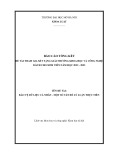
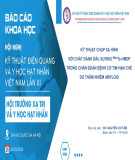

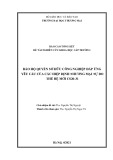
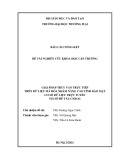
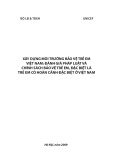
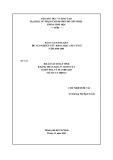
![Vaccine và ứng dụng: Bài tiểu luận [chuẩn SEO]](https://cdn.tailieu.vn/images/document/thumbnail/2016/20160519/3008140018/135x160/652005293.jpg)
